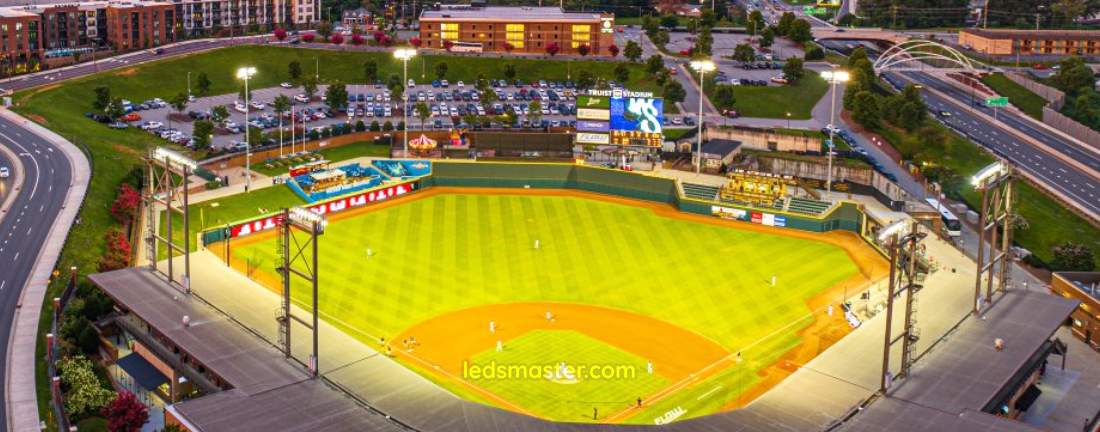
Whether it’s ensuring players see every pitch clearly or creating an atmosphere that captivates fans, choosing the perfect baseball field light poles is crucial. Our selection offers durability, energy efficiency, and compliance with safety standards, providing solutions that illuminate the game with precision and reliability.
Get your complimentary lighting design today
In this article, we will explore the common layouts of light poles on a baseball field, discuss the number of poles and lights typically used, and delve into the weight limitations and other essential considerations for baseball field light poles.
Table of Contents
ToggleThe layout of light poles on a baseball field is strategically planned to provide uniform illumination across the playing surface. A typical baseball field lighting system consists of multiple poles placed at specific locations around the field. The primary goal is to minimize shadows and ensure that all areas, including the infield and outfield, are well-lit.
Infield lighting is crucial as this area requires higher illumination levels due to the concentration of players and the frequent action. Generally, four poles are used to light the infield, positioned at the corners of the diamond. These poles are usually placed outside the foul lines, near the backstop and first and third bases, and sometimes near the pitcher’s mound. The positioning ensures that the infield is brightly lit with minimal shadows, enhancing visibility for players, umpires, and spectators.
The outfield requires broader coverage, and typically, additional poles are needed beyond those used for the infield. Six to eight poles are often used to illuminate the outfield, strategically placed along the outfield fence. These poles are spaced evenly to provide consistent lighting, ensuring that outfielders can track fly balls and that there are no dark spots on the field.
In some cases, additional poles may be installed along the foul lines and in the outfield corners to further enhance lighting uniformity. This is particularly important for larger fields or those used for higher-level competition where optimal lighting is critical.

The number of light poles and fixtures on a baseball field varies depending on the field size, level of play, and lighting standards. For a standard high school or community baseball field, the following configurations are common:
| Area | Number of Poles |
| Infield | 4 |
| Outfield | 6 to 8 |
The number of lights on each pole can vary, but a common setup includes multiple fixtures mounted at different heights to ensure even distribution of light. Each pole may have anywhere from two to eight fixtures, depending on the pole’s location and the required light intensity.
| Area | Number of Lights |
| Infield | These poles often have more fixtures to provide higher illumination levels. Each infield pole may have six to eight fixtures. |
| Outfield | These poles may have fewer fixtures compared to infield poles, with each pole typically having four to six fixtures. |
For a standard baseball field with ten to twelve poles, the total number of lights can range from 60 to 80 fixtures. This setup ensures that the field meets the necessary lighting standards for safe and enjoyable gameplay.
Weight limitations are a critical factor in the design and installation of baseball field light poles. Each pole must be capable of supporting the weight of the lighting fixtures, mounting hardware, and any additional accessories such as cameras or speakers. Exceeding the weight capacity can compromise the structural integrity of the poles and pose safety risks.
Light poles are typically constructed from steel or aluminum, materials chosen for their strength and durability. The poles are designed to withstand not only the weight of the lights but also environmental factors such as wind, rain, and snow. Engineers carefully calculate the load-bearing capacity of each pole to ensure it can support the intended number of fixtures.
The weight of individual lighting fixtures varies depending on their design and technology. LED fixtures, commonly used in modern baseball field lighting, are generally lighter than traditional metal halide fixtures. However, even with lighter LED fixtures, the cumulative weight can add up when multiple fixtures are mounted on a single pole.
In addition to the lights themselves, the mounting hardware, brackets, and crossarms add to the overall weight load. These components must be factored into the weight calculations to ensure the poles can safely support the entire system.
To account for variables such as wind load and potential future additions (e.g., more lights or equipment), engineers incorporate safety margins into their weight calculations. This ensures that the poles can handle not only the current load but also potential increases in weight over time.
In addition to the layout, number of poles, and weight considerations, several other factors are important in designing and installing baseball field lighting systems.
The height of the light poles is crucial for achieving proper light distribution and minimizing glare. For infield lighting, poles are typically 40 to 60 feet tall, while outfield poles can range from 60 to 80 feet in height. Higher poles help distribute light more evenly and reduce the risk of glare affecting players’ vision.
Baseball field lighting standards specify minimum illumination levels and uniformity ratios. For recreational fields, a minimum of 50 foot-candles is common, while professional fields may require up to 100 foot-candles. Uniformity ratios (the ratio of the highest to lowest illumination levels) should be kept low, ideally below 2:1, to ensure consistent visibility across the field.
Glare can be a significant issue in sports lighting, affecting players’ performance and spectators’ comfort. Modern lighting systems use fixtures with advanced optics and shielding to minimize glare. Properly aimed and positioned lights help direct light onto the field and away from players’ eyes and the surrounding community.
Regular maintenance is essential to ensure the longevity and performance of baseball field lighting systems. Light fixtures should be inspected periodically for damage or wear, and any faulty components should be replaced promptly. Additionally, the poles and mounting hardware should be checked for structural integrity and corrosion.
Energy efficiency and environmental impact are important considerations in modern sports lighting. LED fixtures are preferred for their low energy consumption, long lifespan, and reduced light pollution. By choosing energy-efficient lighting solutions, baseball fields can reduce their carbon footprint and operational costs.
Understanding the common layouts, number of poles and lights, weight limitations, and other relevant factors is essential for designing a safe and effective lighting system. By considering these elements and adhering to lighting standards, baseball fields can provide a well-illuminated environment that enhances the overall playing experience.